
BIRDS AS ART BULLETIN #257
Visit www.birdsasart.com
PHOENIX TRIP
GALAPAGOS 2008 OPENING
NEW JERSEY FEDERATION OF CAMERA CLUBS PHOTORAMA
COMING SOON: THE PERFECT TINY BALLHEAD
BAA KUDOS
SHOCKING NEWS ABOUT TODD GUSTAFSON
BIRDPHOTOGRAPHERS.NET/IT AIN'T JUST BIRDS UPDATE
SENSOR SCOPES ON SALE: REDUCED $20!
PORTLAND, MAINE: “The Art of Nature Photography; It Ain’t Just Birds” Weekend How-To Seminar
IPT UPDATES
PROFESSIONAL DUCK PHOTOGRAPHY TIP
Contact us by phone at 863-692-0906 (Eastern Time Zone) or by e-mail at birdsasart@att.net . The att e-mail address is best from overseas.
We gladly accept credit
card orders by phone 8am till
Note: maximize this e-mail for best formatting.
Photographic theme: All drake Ring-necked Ducks photographed at 700mm. Not the great variety even though the subject and the focal length in each image is identical...
Important Request: if responding to this e-mail, please take the time to delete all images and all irrelevant text.

Ring-necked Duck, drake flapping tight, Papago Ponds, Phoenix, AZ
Image Copyright 2008: Arthur Morris/BIRDS AS ART
Canon 500mm f/4L IS lens (with the 4th GD low foot), the 1.4X II TC, and the EOS-1D MIII. ISO 400. Evaluative metering -1/3 stop: 1/1600 sec. at f/7.1. Mongoose M3.5 on Gitzo 3530 LSV CF tripod.
While in Phoenix I photographed this species almost exclusively. This is one of a long blast-burst (11 frame in less than two seconds). I rarely hold the shutter button down but in flapping situation where the bird is lined up perfectly it makes total sence. All were razor sharp; some of the images were perfectly framed while others were not. This is my favorite pose but it was necessary to add canvas (and lots of water from another frame via a Quick Mask) to the bottom. The ORIG is below:

Without Robert O'Toole's APTATS CD the saving the image above would have taken a lot longer than two minutes and the results would have been probelmatic: http://birdsasart.com/aptats.htm
As I drove home from NANPA with Robert O'Toole, I was glad that I had not gotten the flu that was going around as lots of folks had been deblilitated by it. I was a bit premature. By Tuesday I was feeling quite ill and wound up running a fever for three days. I was scheduled to teach a full day seminar on Saturday (March 8) and had In-the-Field Workshops planned for Friday and Sunday. I decided to cancel Friday, fly to Phoenix on Thursday, rest on Friday, teach the seminar on Saturday, and then decide on Sunday. I still had some work to do on my programs for Saturday but whenever I got out of bed on Friday I felt weak and tired. I would work on the shows for a few minutes, climb back into bed, and then sleep another two hours. I wound up finishing the work that needed to be done early on Saturday morning.
I only barely made it through a somewhat long day on Saturday and though I felt beat, decided to do the Sunday In-the-Field. As the Phoenix Zoo does not open until 9am, I took the group to the nearby Papago Ponds. (Thanks to E.J. Peiker for that excellent suggestion. EJ teaches Duck-Shop workshops each winter in the Phoenix area: www.ejphoto.com) My group of five had a great morning with the Ring-necked Ducks. In the afternoon we visited the Gilbert Riparian Preserve without much success. After a second nearly full day of yakking my throat really hurt. As had been the recent pattern with all of the congestion I was experiencing I did not sleep well at all, but decided that I might as well head to Papago for some more Ring-necks. I arrived just as the sun made its way onto the ponds. I set up my gear only to find that I was flash card-less. I smiled, took it as a sign that I needed to rest, and headed back to the hotel for some more much needed sleep.
The next morning I was back at Papago, this time with a flash card <smile> As you view the images that accompany this Bulletin, do consider that I was photographing only the drakes of a single duck species. Note that except for the two head on flapping images, all of the photographs are totally different. It was a wonderful exercise for me, seeing how many different looks I could achieve with the same raw materials...
I fly home through Dallas arriving in Orlando just after 11pm. After a stop in Walgreen's for reinforecments I was home in bed by 1:30 am. Aside from a lingering tickle cough and some congestion I am feeling better thought still a bit weak. I have a local program here in Lake Wales on Saturday night coming and the SW FLA Spring IPT begins on Sunday night. I will be doing some serious resting and breathing lots of steam until then.
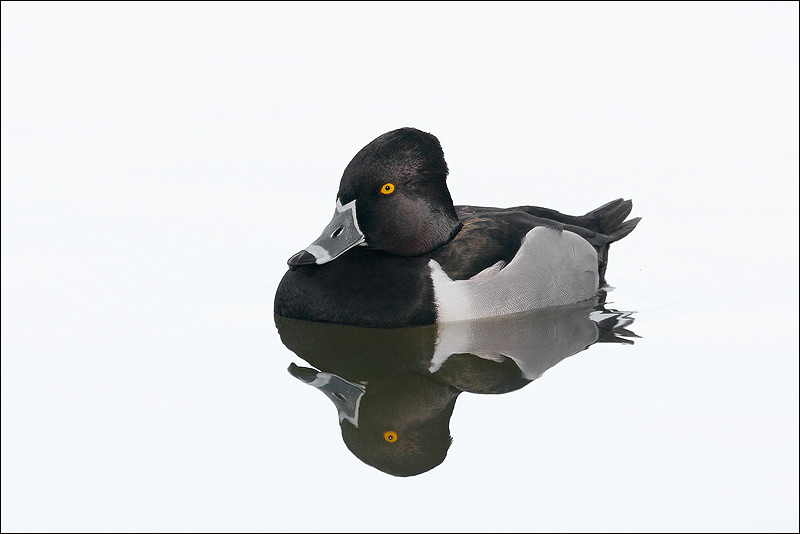
Ring-necked Duck, high key drake, Papago Ponds, Phoenix, AZ
Image Copyright 2008: Arthur Morris/BIRDS AS ART
Canon 500mm f/4L IS lens (with the 4th GD low foot), the 1.4X II TC, and the EOS-1D MIII. ISO 400. Evaluative metering +11/3 stops: 1/500 sec. at f/8 set manually. Mongoose M3.5 on Gitzo 3530 LSV CF tripod.
This bird was floating motionlessly in the shade of a palm tree. While I was subtracting 1/3 stop of light for the drakes in the sun, I knew that the meter would be dumb with the bird in the shade and added lots of light. The original, below and as expected, had a large blue color cast.
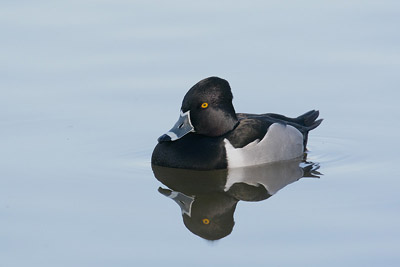
To remove the blue cast I selected the BKGR with the Magic Wand Tool, feathered the selection 1 pixel, went to the Blue channel in Hue Saturation, reduced the Blue SAT 100%, and then moved the Lightness Slider all the way to the right. This gave me the high key look that I wanted. A Shadow/Highlight adjustment revealed the detail in the blacks. All of the techniques mentioned above are covered in detail in our Digital Basics PDF: http://birdsasart.com/digitalbasics.htm
GALAPAGOS 2008
We have a single opening for a male roommate due to a cancellation for this summer’s Galapagos Photo Cruise, July 2-12, 2008. One week on the boat: $5499.00 + $180 fuel surcharge. This trip had been sold out for more than a year. Sorry ladies <smile>. Please call Janie Bullard immediately if you are interested: phone: 770-888-6677 or toll free: 888-419-6677.

Ring-necked Duck, drake flapping, side view, Papago Ponds, Phoenix, AZ
Image Copyright 2008: Arthur Morris/BIRDS AS ART
Canon 500mm f/4L IS lens (with the 4th GD low foot), the 1.4X II TC, and the EOS-1D MIII. ISO 400. Evaluative metering -1/3 stop: 1/1000 sec. at f/8 set manually.
Mongoose M3.5 on Gitzo 3530 LSV CF tripod.
This wing flap was created on the first morning. It was the first frame in a short burst and this wing position is a favorite for the ducks flapping after bathing. I was glad to be able to include the reflections of a mesa on the far side of the pond; it worked out nicely as a third of the frame…
NEW JERSEY FEDERATION OF CAMERA CLUBS PHOTORAMA
Thanks to the generosity of Canon USA I will be doing two Saturday morning programs at this event on April 5. You can learn the details here: http://www.njfcc.org/photorama/2008/2008_flyer.pdf or purchase tickets here: http://www.njfcc.org/photorama/2008/ticket.pdf Rick Sammon will also be appearing.
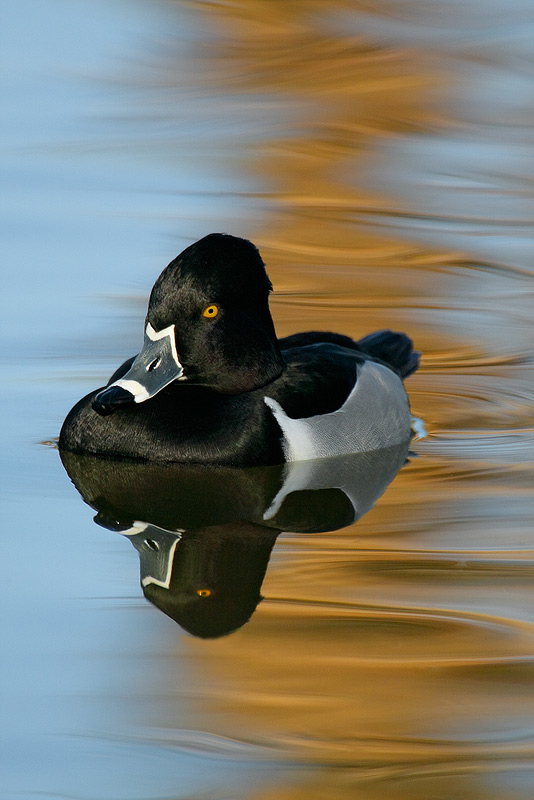
Ring-necked Duck, vertical drake w/golden relfections, Papago Ponds, Phoenix, AZ
Image Copyright 2008: Arthur Morris/BIRDS AS ART
Canon 500mm f/4L IS lens (with the 4th GD low foot), the 1.4X II TC, and the EOS-1D MIII. ISO 400. Evaluative metering +11/3 stops: 1/500 sec. at f/8 set manually. Mongoose M3.5 on Gitzo 3530 LSV CF tripod.
This bird was floating motionlessly in the shade of a palm tree. While I was subtracting 1/3 stop of light for the drakes in the sun, I knew that the meter would be dumb with the bird in the shade and added lots of light. The original, below and as expected, had a large blue color cast. It is rare for a vertical image to work well with more room behind the subject than in front of at (as here) but the position and inclusion of the reflection changes the rules...
COMING SOON: THE PERFECT TINY BALLHEAD
For years folks have been asking if we knew of a lightweight, even tiny ballhead that was strong enough support a pro body and a short lens for scenics. While such a ballhead seemed the perfect solution for folks who for the most part are using long lenses on either Wimberley or Mongoose heads and who on occasion wish to do some landscape photography. Well, at NANPA, I found the perfect tiny ballhead. It is so small that you will not even know that you have it in your photo vest, yet strong enough to support a pro body and a short lens even when doing verticals. They are relatively inexpensive, and best of all, you will not need a cumbersome L plate, just a small plate for the bottom of your camera body. Please see the next Bulletin for details.
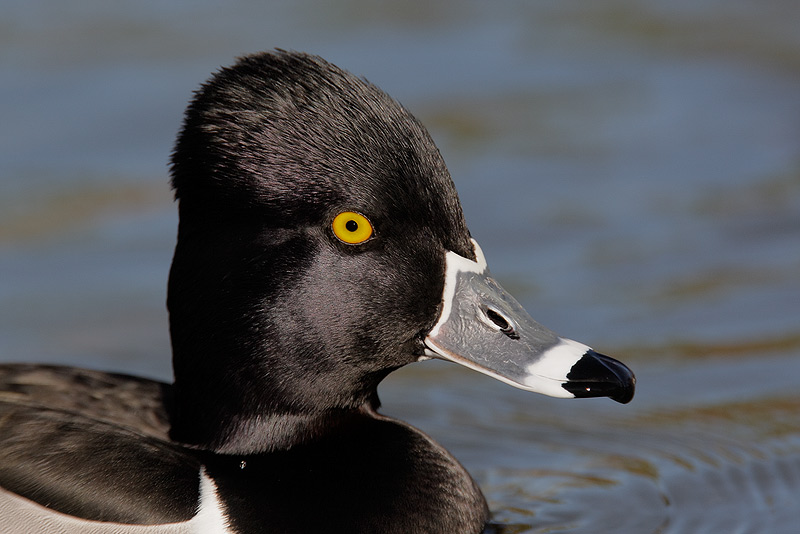
Ring-necked Duck, tight head portrait of drake showing bill detail, Papago Ponds, Phoenix, AZ
Image Copyright 2008: Arthur Morris/BIRDS AS ART
Canon 500mm f/4L IS lens (with the 4th GD low foot), the 1.4X II TC, a 25mm Extension tube, and the EOS-1D MIII. ISO 400. 1/640 sec. at f/7.1 set manually after histogram check. Mongoose M3.5 on Gitzo 3530 LSV CF tripod.
When working tight like this it is imperative to be in manual mode so that large areas of black in the frame will not cause over-exposure. The same would apply if there were large light areas…
BAA KUDOS
Hi Artie, Thanks for sending the Southwest Florida Guide update. It's top notch! I was actually at the Venice rookery with my wife on the morning you were creating the pictures that are in the update. We were in Florida visiting her family and I found my way to the rookery with your guide. I didn't want to interupt your work that morning, but I wanted to take the opportunity now to thank you for the great materials you have put out. Both volumes of The Art of Bird Photography are amazing, and the SWF guide has an indespensable tool. It saved a ton of time searching for the rookery and for the burrowing owls in Cape Coral. Thank you for being such a great resource. Your products and artwork are amazing. Sincerely, Todd Frame
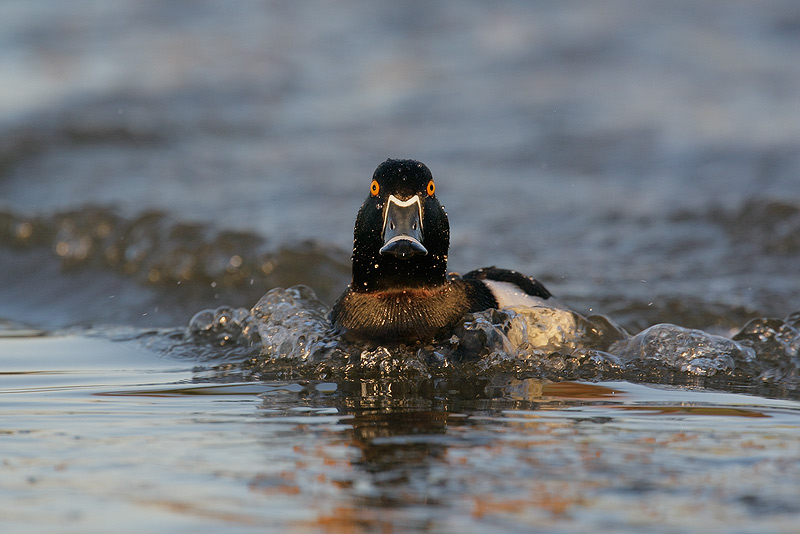
Ring-necked Duck, charging drake, Papago Ponds, Phoenix, AZ
Image Copyright 2008: Arthur Morris/BIRDS AS ART
Canon 500mm f/4L IS lens (with the 4th GD low foot), the 1.4X II TC, and the EOS-1D MIII. ISO 400. Evaluative metering -1/3 stop: 1/500 sec. at f/8. Mongoose M3.5 on Gitzo 3530 LSV CF tripod.
The ring-necks at Papago Ponds responded eagerly to bread on my first morning there. I used the central sensor to create this image. The diagonal wavelet in the background adds strength to this image, as do all the bubbles.
SHOCKING NEWS ABOUT TODD GUSTAFSON
Unbeknownst to most, and unnoticed by many, I cancelled my trip to Tanzania and Madagascar shortly after returning from San Diego this past January due to a variety of health concerns including but not limited to the two parasites that traveled home with me from my last Kenya trip. Severe wheat allergy reactions left me more susceptible than most. Todd was left to both lead the trip on his own while going about the task of creating great images in his beloved East Africa. The shocking news is that without my presence Todd managed to create a large portfolio of outstanding images. Well, not exactly shocking: Todd is (and has been for several years) an extremely talented photographer who very works hard at what he does. You can view a collection of his favortie Tanazania 2008 images here: http://www.gustafsonphotosafari.net/galleries/TZ08/index.htm A gallery of his Madagascar images will be coming soon.
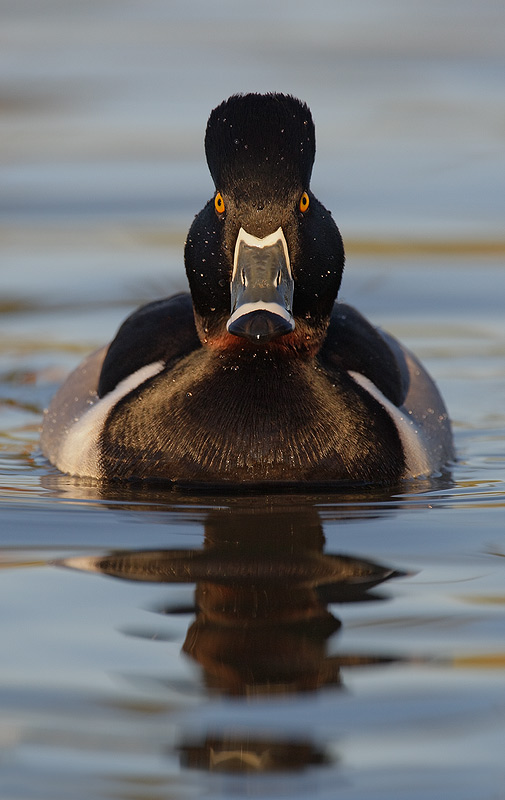
Ring-necked Duck, head-on vertical drake, Papago Ponds, Phoenix, AZ
Image Copyright 2008: Arthur Morris/BIRDS AS ART
Canon 500mm f/4L IS lens (with the 4th GD low foot), the 1.4X II TC, and the EOS-1D MIII. ISO 400. Evaluative metering -1/3 stop: 1/500 sec. at f/8. Mongoose M3.5 on Gitzo 3530 LSV CF tripod.
I wanted to create a vertical image that showed the head shape of this species. I suceeded with this one, using the central sensor placed on the upper central part of the bird's breast. I Qick Masked some feathers from the sides of the breast to cover some specular highlights in the center of the chest just above the waterline.
BIRDPHOTOGRAPHERS.NET/IT AIN'T JUST BIRDS UPDATE
Check out Marko Matesic's elgant lamingoes in black water here: http://www.birdphotographers.net/forums/showthread.php?t=7383 Marko, one of BPN's many skilled overseas contributors, is from Rijeka,Croatia.
Simon Bennet, of Canberra, Australia, has posted a stunning Satin Bowebird here: http://www.birdphotographers.net/forums/showthread.php?
LA's Jeff Wear has posted some wicked battling coots here: http://www.birdphotographers.net/forums/showthread.php?t=7357
Rosl Roessner's immature Lammerrgeier in Avian Captive and Hand of Man will put a smile on your face: http://www.birdphotographers.net/forums/showthread.php?t=7287
Steve Canuel's Late Spring Coyote breaks the rules of composition but works very nicely in Wildlife: http://www.birdphotographers.net/forums/showthread.php?t=7442
For those of you who love the pink purple/earth shadow light, check out Roman Kurywczak's Dusk at Balanced Rocks here: http://www.birdphotographers.net/forums/showthread.php?t=6587 Be sure to scroll down to Robert Amoruso's great repost.
BirdPhotographers.Net/It Ain't Just Birds (www.BirdPhotographers.Net)
has quickly become the number one educational and critiquing web site on the
planet and continues
to improve. A quick visit to any of the galleries
will reveal that our philosophy of "honest critiques done gently" and leading by
example are succeeding quite well. (If you are a first time visitor, you will be
prompted to register. Registration is free.) Folks who will be using our image
hosting services or otherwise wish to support our efforts are invited to become
members by clicking here: http://www.birdphotographers.net/forums/membership.aspx).
Though
membership is free up until

Ring-necked Duck, calling drake, Papago Ponds, Phoenix, AZ
Image Copyright 2008: Arthur Morris/BIRDS AS ART
Canon 500mm f/4L IS lens (with the 4th GD low foot), the 1.4X II TC, and the EOS-1D MIII. ISO 400. Evaluative metering -1/3 stop: 1/500 sec. at f/6.3 set manually. Mongoose M3.5 on Gitzo 3530 LSV CF tripod.
I needed to rotate this image about 2 degrees clockwise to make it square to the world.
SENSOR SCOPES ON SALE: REDUCED $20!
Before Lens Pens changed the world of sensor cleaning (http://www.birdsasart.com/lenspens.htm), I can remember using the wet method and creating test slide after test slide in an effort to determine whether or not the sensor was actually clean. Clean the sensor, walk to the front door, photograph the sky at f/22, remove the card, download the image, and then do it again and again and again. I can actually remember being so frustrated as to be near tears. While the Lens Pens have made actually cleaning the sensor tons easier, the Sensor Scope has been even more beneficial when it comes to getting a clean sensor quickly, efficiently, and easily. Instead of having to create test image after test image you simply get a close-up look at your sensor and clean away only the specks that you see. And best of all, they will be exactly where you see them through the scope; a single flick of the Lens Pen and you are good to go. You only need to clean what needs to be cleaned… Due to a volume purchase from Delkin we are proud to be able to cut the price of the Sensor Scope alone by $20.
You can order a SensorScope today for only $59.98 plus $7.00 shipping and handling in the US. The total is $66.98. Florida residents please add 7% sales tax to the cost of the item only: ($71.18. total). Overseas customers please e-mail your complete ship-to address to receive a shipping quote. Paypal is quite convenient. You can call us at 863-692-0906 with credit card in hand, or send a check for the correct amount made out to “Arthur Morris” to us as follows: Arthur Morris/BIRDS AS ART, PO Box 7245, 4041 Granada Drive, Indian Lake Estates, FL 33855.
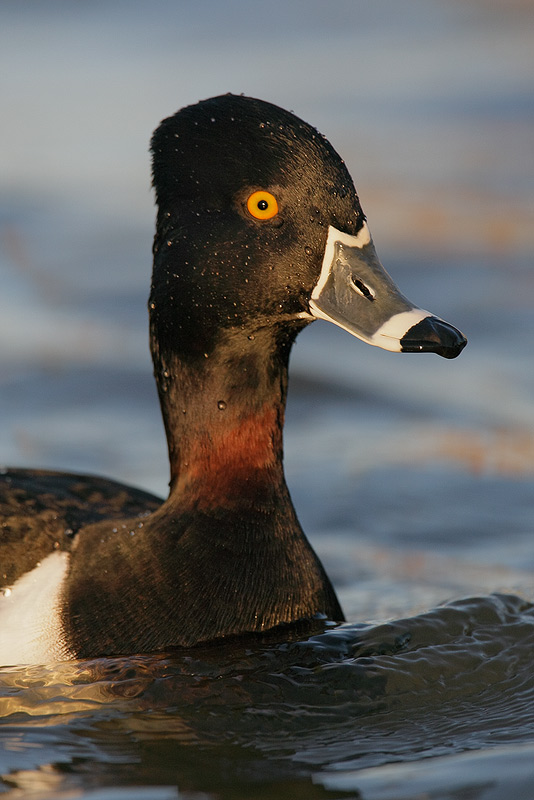
Ring-necked Duck, vertical drake showing neck ring, Papago Ponds, Phoenix, AZ
Image Copyright 2008: Arthur Morris/BIRDS AS ART
Canon 500mm f/4L IS lens (with the 4th GD low foot), the 1.4X II TC, (borrowed) 36mm Kenko Extension tube, and the EOS-1D MIII. ISO 400. Evaluative metering -1/3 stop: 1/500 sec. at f/8 set manually. Mongoose M3.5 on Gitzo 3530 LSV CF tripod.
A Shadow/Highlight adjustment of approximately 15/25/30 was used to open up the details in the black neck and head. Compare the blacks in the optimized image above with the blacks in the original below.
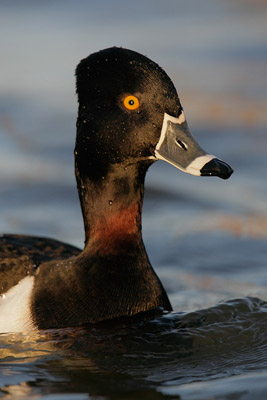
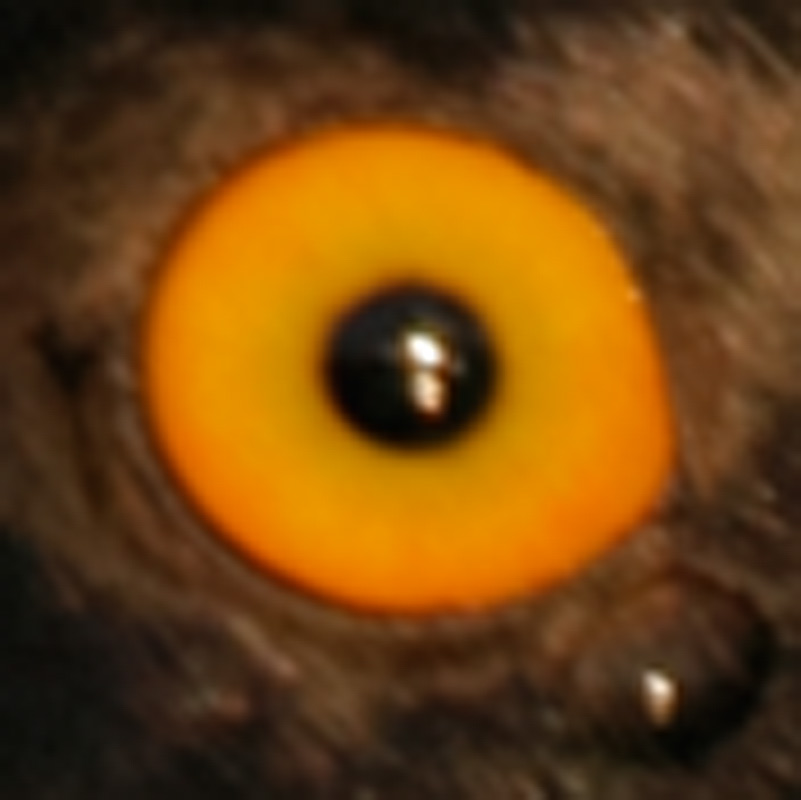
Compare the original eye above with the optimized eye below. Note the blacker pupil with a single highlight and the desaturated yellows of the iris. Similar work was done on the eyes of all of the images in this Bulletin. I used Quick Masks (http://birdsasart.com/aptats.htm) and various techniques covered in detail in our Digital Basics PDF: http://birdsasart.com/digitalbasics.htm
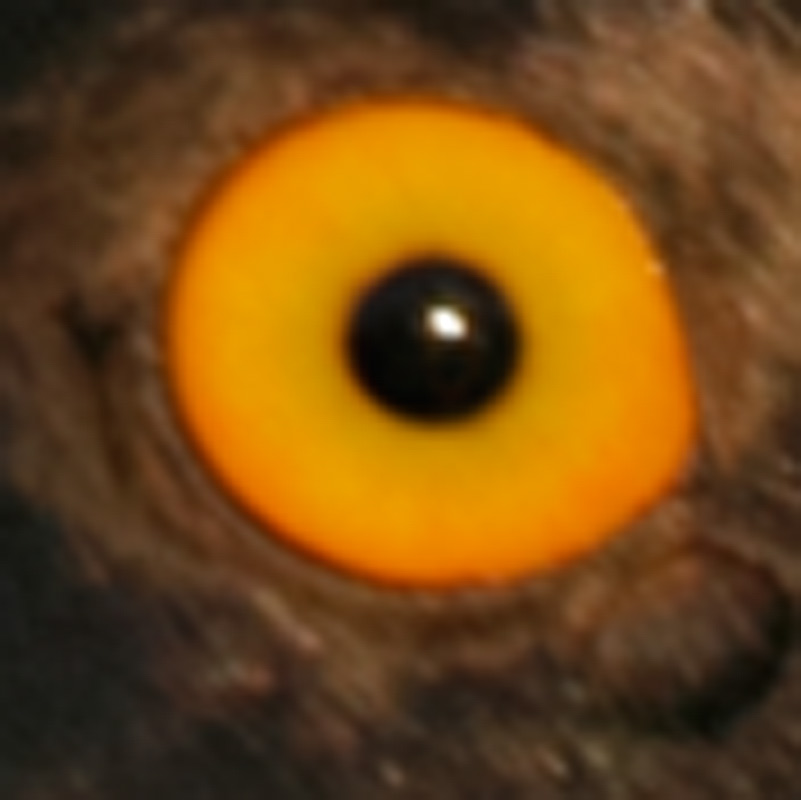
PORTLAND, MAINE: “The Art of Nature Photography; It Ain’t Just Birds” Weekend How-To Seminar
“The Art of Nature Photography; It Ain’t Just Birds” Weekend How-To Seminar in Portland, Maine
October 11-12, 2008
Eastland Park Hotel, 157 High Street, Portland, ME
The October 11-12 date was carefully chosen to coincide roughly with the average peak of fall color in southern Maine. The likelihood is that if you are coming from out of town and would like to photograph the fall color the best bet (taking global warming and the trends in recent years) would be to schedule your photography in the days following the seminar. Every year, however, is different, and this is nature photography so there are no guarantees, but chances are, whether you photograph just before or just after the seminar you should have many chances to create some great images. Best bet: come a few days early and stay on for a few days… (Hint: hope for a pre-dawn rainstorm followed by the sun breaking through in the east while grayish-black storm clouds fill the western sky…)
The seminar will be held at the Eastland Park Hotel. Folks staying at least two nights in the hotel will receive a free Lens Pen Combo Kit at the seminar. As fall color time is peak season in southern Maine, hotel rates are high anywhere in the region. We were able to negotiate a rate of $159 for folks registering early. Once the block of rooms is gone, higher rates will apply. The doors will open on both days at 8 am and the programs will begin at 9 am sharp. There will be tons of great door prizes (including Delkin e-film Pro compact flash cards and some great stuff from Lowepro and Wimberley). I hope that you will be able to join me for what will be an incredibly educational and fun-filled weekend. (If anyone would like to help us set up or to hang out, be there at 7:00am.)
This seminar is for all nature photographers who want to learn how to make better photographs. On Saturday I will describe the methods and techniques that I have developed and used since 1983. My comments on equipment (including and especially digital equipment), autofocus, light, and on composition and image design, and my tips on getting close to free and wild subjects and creating pleasing blurs will benefit everyone with a telephoto lens who wishes to dramatically improve the quality of their images. Since going all-digital in November 2002, I have--in short order--become a digital photography and Photoshop expert. My approach to optimizing images is to create a master file of excellent quality in the shortest possible time. I will share our workflow and numerous Digital and Photoshop tips on Sunday. As more and more folks are using Digital Capture, I am finding on our IPTs that many good to excellent photographers have no clue as to how to use Photoshop to make their images look better. In fact, many of them make their best images look worse! My workflow is designed to quickly produce master files of high quality. I can and will teach you to do just that at this seminar.
The cost of the weekend seminar will be $169. The cost of either single day will be $99. Members of qualifying camera clubs are invited to apply a $10 discount. (If you are a member of a camera club or other photography organization please e-mail us before registering to learn how your group can become a qualifying club). Register with a friend or a spouse and take $10 off each registration. Register in groups of four or more and take $20 off of each registration. Register in a group of ten or more and take $30 off each registration. It is highly recommend that folks purchase the buffet luncheon option ($15/day includes tip and tax). Those purchasing the lunch option will receive their lunch coupon when they check in each morning.) The cost of the weekend seminar plus the two lunches is $199.
To register, send a check for the full amount made out to "Arthur Morris" to PO Box 7245, Indian Lake Estates, FL 33855, call with a credit card: 863-692-0906, or send a Paypal (using either any link on our site or your Paypal account) to us at birdsasart@att.net In all cases, we will need your e-mail address, your mailing address, and your daytime and evening phone numbers. Here is our Cancellation Policy: If for any reason you need to withdraw, please notify us ASAP. Once we receive your e-mail, phone call, or written notice of your cancellation the following fees apply: cancel before July 10, 2008 and your fee will be refunded less a $20.00 cancellation fee; cancel by August 10, 2008 and your fee will be refunded less a $50.00 cancellation fee; cancel after September 10, 2008 and there will be no refund.
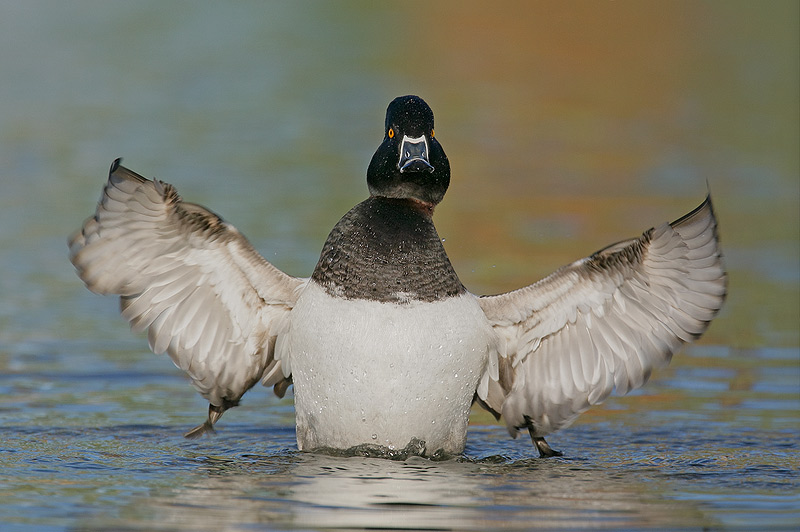
Ring-necked Duck, drake flapping tight, Papago Ponds, Phoenix, AZ
Image Copyright 2008: Arthur Morris/BIRDS AS ART
Canon 500mm f/4L IS lens (with the 4th GD low foot), the 1.4X II TC, and the EOS-1D MIII. ISO 400. Evaluative metering -1/3 stop: 1/1600 sec. at f/7.1. Mongoose M3.5 on Gitzo 3530 LSV CF tripod.
This was the first frame of the blast-burst. Note that the black on the neck is brighter than in the first image in this Bulletin, due both to the way the light hit the feathers and a bit more Shadow/Highlight. The eyes are level in this one but it may need a bit of CCW rotation…
IPT UPDATES
Bosque IPT
#1:
Bosque IPT #2: NOV 29-DEC 2, 2008. Slide program on the evening of NOV 28. 4-DAY: $1799 (Limit: 10/Openings: 4)
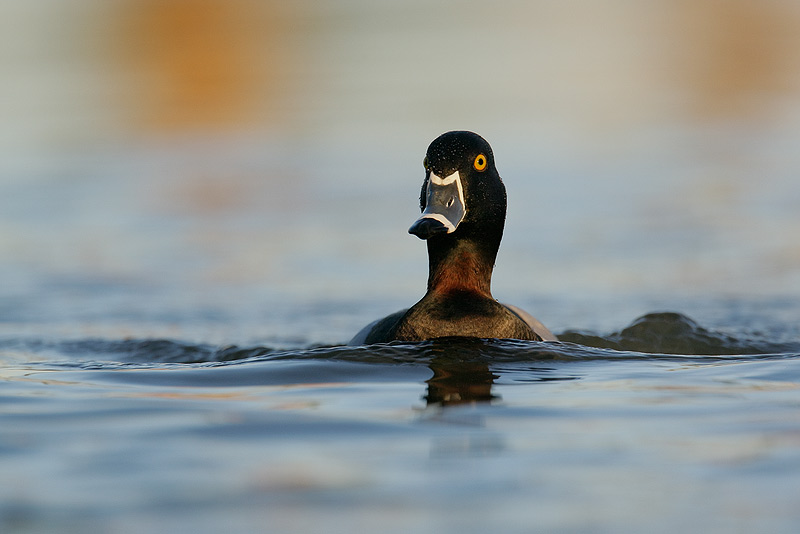
Image Copyright 2008: Arthur Morris/BIRDS AS ART
Canon 500mm f/4L IS lens (with the 4th GD low foot), the 1.4X II TC, and the EOS-1D MIII. ISO 400. Evaluative metering +1/3 stop: 1/640 sec. at f/7.1. Mongoose M3.5 on Gitzo 3530 LSV CF tripod.
On my second and last morning, I got right down on the ground in the gravel right off the bat but the birds were not as repsonsive to the bread as they had been the first morning; I had far fewer chances.
PROFESSIONAL DUCK PHOTOGRAPHY TIP
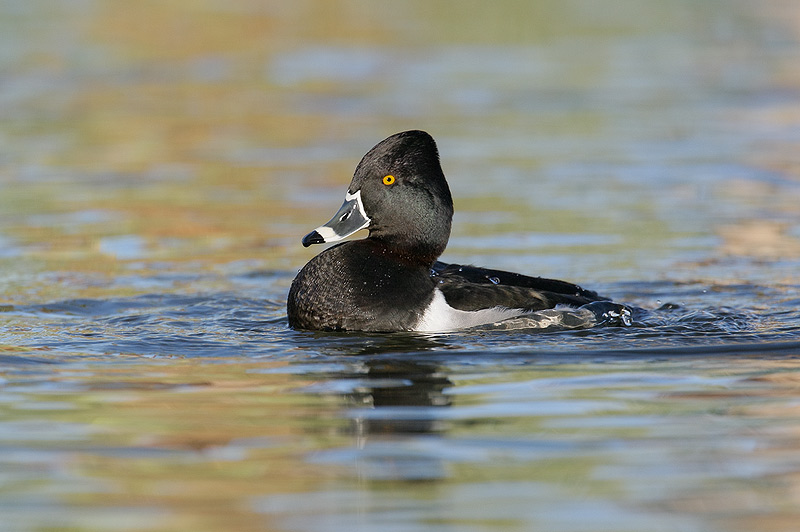
Ring-necked Duck, drake ready to flap after bath, Papago Ponds, Phoenix, AZ
Image Copyright 2008: Arthur Morris/BIRDS AS ART
Canon 500mm f/4L IS lens (with the 4th GD low foot), the 1.4X II TC, and the EOS-1D MIII. ISO 400. Evaluative metering -1/3 stop: 1/1000 sec. at f/7.1. Mongoose M3.5 on Gitzo 3530 LSV CF tripod.
Most ducks will flap their wings after bathing. They dip their breasts in the water and splash about. Right before they are going to flap, they lean back a bit and rise up slightly out of the water (as above). That is your signal to get ready to fire a burst. Fore-warned is fore-armed.
…..
Best and love and great
picture-
artie
Note: Arthur Morris has been a
Canon contract photographer since 1996 and
continues in that role today. Hunt's Photo of Boston, MA is a BAA sponsor as is
Delkin Devices. Back issues of all BAA Bulletins can be found in the Bulletin
Archives which